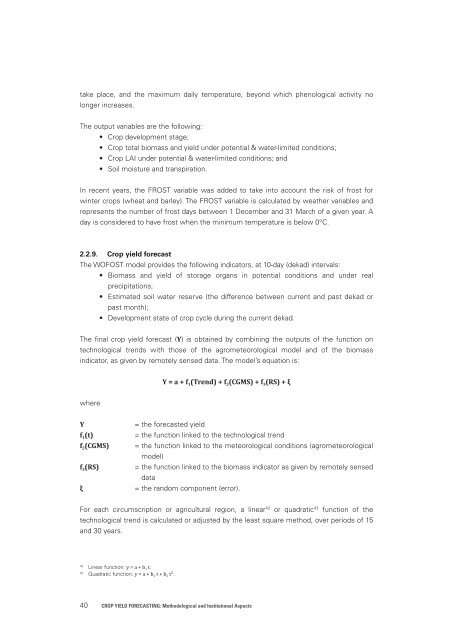Crop Yield Forecasting
1qKZxmS
1qKZxmS
Create successful ePaper yourself
Turn your PDF publications into a flip-book with our unique Google optimized e-Paper software.
take place, and the maximum daily temperature, beyond which phenological activity no<br />
longer increases.<br />
The output variables are the following:<br />
• <strong>Crop</strong> development stage;<br />
• <strong>Crop</strong> total biomass and yield under potential & water-limited conditions;<br />
• <strong>Crop</strong> LAI under potential & water-limited conditions; and<br />
• Soil moisture and transpiration.<br />
In recent years, the FROST variable was added to take into account the risk of frost for<br />
winter crops (wheat and barley). The FROST variable is calculated by weather variables and<br />
represents the number of frost days between 1 December and 31 March of a given year. A<br />
day is considered to have frost when the minimum temperature is below 0°C.<br />
2.2.9. <strong>Crop</strong> yield forecast<br />
The WOFOST model provides the following indicators, at 10-day (dekad) intervals:<br />
• Biomass and yield of storage organs in potential conditions and under real<br />
precipitations;<br />
• Estimated soil water reserve (the difference between current and past dekad or<br />
past month);<br />
• Development state of crop cycle during the current dekad.<br />
The final crop yield forecast (Y) is obtained by combining the outputs of the function on<br />
technological trends with those of the agrometeorological model and of the biomass<br />
indicator, as given by remotely sensed data. The model’s equation is:<br />
Y = a + f 1 (Trend) + f 2 (CGMS) + f 3 (RS) + ξ<br />
where<br />
Y<br />
f 1 (t)<br />
f 2 (CGMS)<br />
f 3 (RS)<br />
ξ<br />
= the forecasted yield<br />
= the function linked to the technological trend<br />
= the function linked to the meteorological conditions (agrometeorological<br />
model)<br />
= the function linked to the biomass indicator as given by remotely sensed<br />
data<br />
= the random component (error).<br />
For each circumscription or agricultural region, a linear 42 or quadratic 43 function of the<br />
technological trend is calculated or adjusted by the least square method, over periods of 15<br />
and 30 years.<br />
42<br />
Linear function: y = a + b 1 t.<br />
43<br />
Quadratic function: y = a + b 1 t + b 2 t².<br />
40<br />
<strong>Crop</strong> <strong>Yield</strong> <strong>Forecasting</strong>: Methodological and Institutional Aspects


